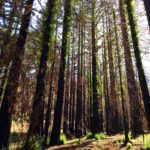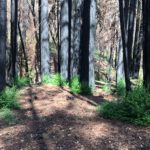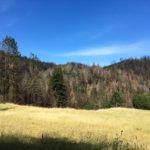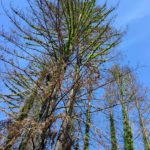June 11, 2018
Posted in: News Articles
Regrowth and regeneration at Mark West properties
Our Mark West properties, slated to become part of the future Mark West Creek Regional Park & Open Space Preserve, burned in the first night of the Tubbs fire. Driven by fierce winds and hot, dry conditions, the fire ran up the forested slope above Mark West Creek, charring nearly every tree to its branch tips. These trees were mostly conifers — Douglas-fir and coast redwood, with a smattering of hardwood species such as madrone, oaks, and California bay laurel. In our immediate post-fire assessments, Ag + Open Space staff noted that this northeast-facing slope was one of the most severely burned portions of our complex of Mark West properties. Almost no green canopy remained, smaller branches had burned away, the forest floor was cleared to bare mineral soil, and we anticipated that many of the trees on the slope would not survive.
During a visit to these properties last week, we were delighted to see that at least half of the trees on this previously blackened slope were greening up. The coast redwoods are especially noticeable on the slope. Redwoods have the ability to re-sprout from their bases and can also sprout epicormically — that is, directly from their trunks and branches. Along these burned slopes, the coast redwoods are now cloaked in bright green along their lengths, and the new sprouts at their bases are already several feet high and poised to grow rapidly should the upper trunks fail to survive. Scattered Douglas-fir remain alive across the slope as well, and these trees will likely provide seeds that will allow this species to re-colonize the forest. Meanwhile, and especially along the riparian corridors, the native hardwoods are vigorously resprouting, and native wildflowers and plants have already covered much of the ground.
Climate change is expected to create increasingly challenging conditions for the survival of certain of our native trees, plants, and vegetation communities. While most of us are familiar with the idea of animals needing open corridors in order to disperse and find good habitat, plants need to do likewise in response to changing climate conditions — for example, moving to higher elevations, north-facing slopes, or higher latitudes in response to warming temperatures. This “movement” is relatively slow and must take place over generations, and it requires that there be available space for new seedlings to move into. Fire is one disturbance agent that can enable this — clearing away competing vegetation and litter and duff that can interfere with seed germination, and creating open areas that nearby species can populate.
Perhaps the burned slopes along Mark West Creek can help provide this kind of new habitat for our native species. Certainly, the fire re-set a successional process in this forest. Many — though not all — of the Douglas-fir trees were killed on these slopes, while many of the oaks, madrones, and coast redwoods survived. We might expect to see a more open and diverse forest establish in this area, with coast redwoods strongly favored — at least until the shade-tolerant Douglas-firs begin to crowd in again!
In the meantime, we have a lot of standing, burned trees on our hands. Burned trees, while not necessarily photogenic, can provide important foraging and nesting habitat for woodpeckers and other wildlife. Landowners whose properties burned in the 2004 Geysers Fire have told us about the large numbers of woodpeckers they observed in the first few years after the fire, and we heard pileated woodpeckers calling to each other from within the burned forest during our recent Mark West visit.
Conifer forests typically recover more slowly from fire than some of our other vegetation communities, but we’re happy to report that this recovery is well underway on our Mark West properties. We look forward to seeing how the forest rearranges itself in the coming years, and who will choose to call it home.



